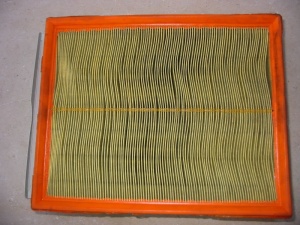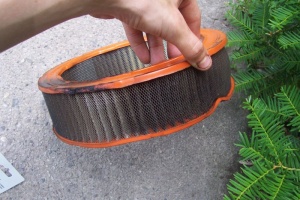Air filter


An air filter is a device which removes contaminants, often solid particulates such as dust, pollen, mold, and bacteria from air. Air filters are used in application where air quality is important, notably in building ventilation systems and in engines, such as internal combustion engines, gas compressors, diving air compressors, gas turbines and others.
Some buildings, as well as aircraft and other man-made environments (e.g., satellites and space shuttles) use foam, pleated paper, or spun fiberglass filter elements. Another method uses fibers or elements with a static electric charge, which attract dust particles. The air intakes of internal combustion engines and compressors tend to use either paper, foam, or cotton filters. Oil bath filters have fallen out of favor. The technology of air intake filters of gas turbines has improved significantly in recent years, due to improvements in the aerodynamics and fluid-dynamics of the air-compressor part of the Gas Turbines.
Air Condition / Heater Filter
Heat & Cool Efficiently
As much as half of the energy used in houses goes to heating and cooling. So making smart decisions about home's heating, ventilating, and air conditioning (HVAC) system can have a big effect on utility bills.
Changing Air Filters
Energy Star advises air filters be checked every month, especially during heavy use months (winter and summer). If the filter looks dirty after a month, it should be changed. The air filter should be changed at least every 3 months. A dirty filter will slow down air flow and make the system work harder and use more energy to warm or cool. Improper air flow can cause air conditioning components to freeze. A clean filter will also prevent dust and dirt from building up in the system which can lead to expensive maintenance and/or early system failure.
Climate control air filters
There are four main types of mechanical air filter media: paper, foam, synthetics, and cotton.
Air filters are found in most all forced-air heating, ventilation, and air conditioning systems. The efficacy of the air filters in such systems significantly affects the Indoor Air Quality. The United States Department of Energy advises that "[Air] Filtration should have a Minimum Efficiency Reporting Value (MERV) of 13 as determined by ASHRAE 5.2.2-1999." There are a variety of different types of HVAC filters available. Many are inexpensive and not very efficient. Some options are panel, pleated, electrostatic, HEPA, electronic and media. ASHRAE recommends (MERV 6 or higher) air filters to lower the amounts of pollen, mold and dust that reaches the wet evaporator coils in air conditioning systems. Wet coils contaminated with high levels of pollen and dust can allow mold colonies to grow.
Polyester and/or glass fibres are commonly used to make web formations used for air filtration. Both materials have high temperature ratings of at least 120°C (250°F), and are widely used in commercial, industrial and residential applications. Polyester and glass fibres can be blended with cotton or other fibres to produce a wide range of performance characteristics. In some cases Polypropylene, which has a lower temperature tolerance, is used to enhance chemical resistance. Tiny synthetic fibres known as microfibres are used in many types of HEPA (High Efficiency Particulate Air) filters.
Many in-duct filters for home forced air heating and air conditioning systems are made from plain, loosely-spun fiberglass. These filters are inexpensive, disposable, and come in various densities and sizes. Less-dense filters allow for higher airflow, but do not remove as much dust. Higher density filters remove more particles, but are more expensive and offer more resistance to the air. They also become more quickly "loaded" with contaminants and dust.
Automotive cabin air filters
The cabin air filter is typically a pleated-paper filter that is placed in the outside-air intake for the vehicle's passenger compartment. Some of these filters are rectangular and similar in shape to the combustion air filter. Others are uniquely shaped to fit the available space of particular vehicles' outside-air intakes. Being a relatively recent addition to automobile equipment, this filter is often overlooked and clogged or dirty cabin air filters can significantly reduce airflow from the cabin vents, as well as introduce allergens into the cabin air stream.
Internal combustion air filters
The combustion air filter prevents abrasive particulate matter from entering the engine's cylinders, where it would cause mechanical wear and oil contamination.
Most modern, fuel-injected vehicles use a pleated paper filter element in the form of a flat panel. This filter is usually placed inside a plastic box connected to the throttle body with a large pipe.
Older vehicles that use carburetors or throttle body fuel injection typically use a cylindrical air filter, usually a few inches high and between 6 and 16 inches in diameter. This is positioned above the carburetor or throttle body, usually in a metal or plastic container which may incorporate ducting to provide cool and/or warm inlet air, and secured with a metal or plastic lid.
Paper
Pleated paper filter elements are the nearly exclusive choice for automobile engine air cleaners, because they are efficient, easy to service, and cost-effective. The "paper" term is somewhat misleading, as the filter media are considerably different from papers used for writing or packaging, etc. There is a persistent belief amongst tuners, fomented by advertising for aftermarket non-paper replacement filters, that paper filters flow poorly and thus restrict engine performance. In fact, as long as a pleated-paper filter is sized appropriately for the airflow volumes encountered in a particular application, such filters present only trivial restriction to flow until the filter has become significantly clogged with dirt.
Foam
Oil-wetted polyurethane foam elements are used in some aftermarket replacement automobile air filters. Foam was in the past widely used in air cleaners on small engines on lawnmowers and other power equipment, but automotive-type paper filter elements have largely supplanted oil-wetted foam in these applications. Depending on the grade and thickness of foam employed, an oil-wetted foam filter element can offer minimal airflow restriction or very high dirt capacity, the latter property making foam filters a popular choice in off-road rallying and other motorsport applications where high levels of dust will be encountered.
Cotton
Cotton is employed in a small number of aftermarket automotive air filters marketed as high-performance items. In the past, cotton gauze saw limited use in original-equipment automotive air filters.
Oil Bath
An oil bath air cleaner consists of a round base bowl containing a pool of oil, and a round insert which is filled with fibre, mesh, foam, or another coarse filter media. When the cleaner is assembled, the media-containing body of the insert sits a short distance above the surface of the oil pool. The rim of the insert overlaps the rim of the base bowl. This arrangement forms a labyrinthine path through which the air must travel in a series of U-turns: up through the gap between the rims of the insert and the base bowl, down through the gap between the outer wall of the insert and the inner wall of the base bowl, and up through the filter media in the body of the insert. This U-turn takes the air at high velocity across the surface of the oil pool. Larger and heavier dust and dirt particles in the air cannot make the turn due to their inertia, so they fall into the oil and settle to the bottom of the base bowl. Lighter and smaller particles are trapped by the filtration media in the insert, which is wetted by oil droplets aspirated thereinto by normal airflow.
Oil bath air cleaners were very widely used in automotive and small-engine applications until the widespread industry adoption of the paper filter in the early 1960s. Such cleaners are still used in off-road equipment where very high levels of dust are encountered, for oil bath air cleaners can sequester a great deal of dirt relative to their overall size, without loss of filtration efficacy or airflow. However, the liquid oil makes cleaning and servicing such air cleaners messy and inconvenient, they must be relatively large to avoid excessive restriction at high airflow rates, and they tend to increase exhaust emissions of unburned hydrocarbons due to oil aspiration when used on spark-ignition engines.
See also
External links
- Comparative filtration efficacy and airflow tests for different types of automotive air filter elements
- Engineered Systems Magazine Filter Selection: A Standard Procedure (June 2000) MERV designations (Minimum Efficiency Reporting Value)
- ASHRAE At least a MERV 6 filter upstream of any wet-surface devices, such as air conditioning coils
- U.S.E.P.A. Indoor Air Quality, Federal Interagency Committee
